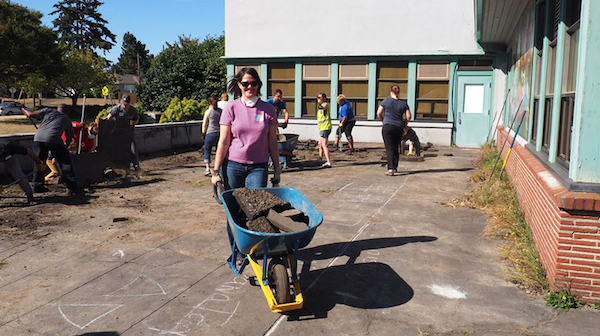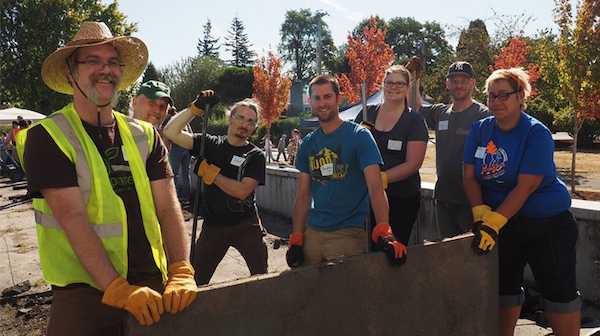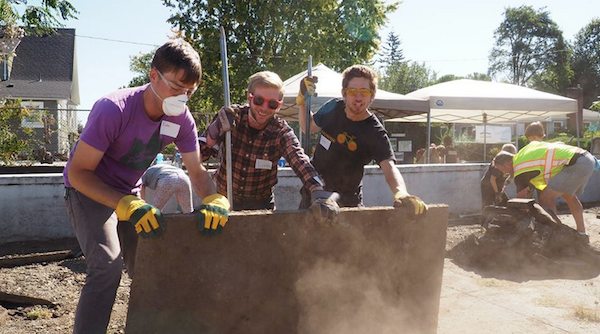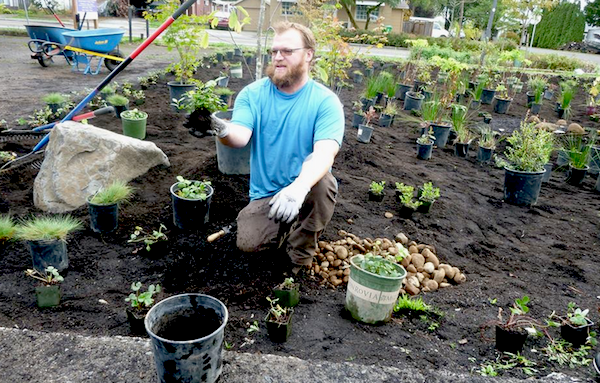How much thought do you give to pavement? Our cities are covered with it, but it’s not exactly a hot topic of conversation—though it should be. Pavement causes all sorts of problems including the fact that water can’t soak through it and instead runs across it, collecting pollutants and biological contaminants that make their way into waterways, plants, animals, and ourselves.
Depaving is the act of removing pavement and freeing up the soil below. Doing so reestablishes balanced ecosystems. Depave, a Portland-based nonprofit promoting the “transformation of over-paved places,” put together a guide to help people depave in their own communities.
As How to Depave: the Guide to Freeing Your Soil states, “the removal of impervious pavements will reduce stormwater pollution and increase the amount of land available for habitat restoration, urban farming, trees, native vegetation, and beauty, thus providing us with greater connections to the natural world.”
Here’s are Depave’s key points to depaving.
Preparation
Before you start tearing pavement up, do some research. Things to consider include how water interacts with the site; what drainage currently exists; and where the downspouts from existing buildings send water. There may be opportunities to disconnect downspouts from sewer lines and utilize the newly-depaved area for on-site infiltration.
Depave suggests contacting your local city or county for guidance on stormwater retrofit
information and design. You’ll need to find out how removing pavement will affect adjacent areas. For a first time depaving project, start with a small lot of 500 square feet or less.
“Once the site has been selected,” the guide reads, “discuss depaving with the property owner and get written approval for the project. Next, research the history of your site and test your soil. Then, create a vision for the future greenspace and depict it in a site plan.”

Determine Site History and Soil Health
Before you depave, determine the condition of the underlying soil. Start with researching the history of the site. You can do this at your local library or assessor’s office, and by viewing land deeds.
A common urban soil contaminant you may find is lead, from lead paint, older construction, and older houses. Depave recommends testing for lead, cadmium, hydrocarbons, arsenic, and organochlorine pesticides if the post-depave plan includes growing food.
If you find these contaminants, Depave discourages removing pavement as the contamination is capped and is not causing any severe negative environmental or health impacts. “Unless there is a cleanup plan in place,” they write, “removing the pavement may do more harm than good.”
Another test to run is an infiltration test which will help determine if the soil is suitable for certain types of stormwater management systems. This test measures how quickly water can soak in and flow through the soil and can be easily performed. Note: the How to Depave appendices provided detailed step-by-step instructions for testing soil.

Site Development Plan
Once you’ve determined the site conditions, create a plan for improving the space. As Depave explains, “A well executed depaving can help revitalize a neighborhood space with features that can: manage stormwater, provide habitat diversity for urban wildlife, reduce the urban heat island effect, and/or provide garden space for community members.”
Depaved sites can be used as stormwater management devices. Common ways to do this include the following:
- Vegetated bioswales which slow runoff
- Rain gardens, which store runoff until it can be infiltrated into the ground
- Planters, including infiltration planters, contained planters, and flow through planters, which beautify the site and slow runoff
- Trees and naturescaping with evergreen trees and native plants, which also beautify the site and slow runoff
- Learning gardens for people to experience growing food and plants in an educational setting
- Community food gardens and orchards. These can have raised beds for soils with low permeability or if there is any possible soil contamination, and individual garden plots to provide garden space for many people and build community around the garden
Create a Plan
Before depaving you’ll need a detailed drawing of the site including what changes are being proposed. This may be required by your city and will be helpful in determining what materials will be needed, the budget, and how it will look when the project is complete. You may need permits from various city departments.
From the Depave guide: “Your site plan should clearly depict: where you propose to depave, a scale, a north arrow, elevation points and water flow across the site, stormwater drains, important project notes, as well as existing and proposed structures and trees. These drawings do not need to be polished documents, but do need to be drawn to scale and thoroughly detail the elements of your proposal.”
Reach out to the community when creating your plan. You may find design professionals who can help create and visualize your plan for a future greenspace.

Create a Plan for Recycling the Pavement
When it comes to depaving, you’ll need to determine what surface material you’ll be removing and what you’ll do with it once you’ve removed it. Concrete can be repurposed and reused to construct walkways, flower beds, fire pits, retaining walls and other outdoor structures. Asphalt can be recycled by local pavement processing companies into a crushed rock aggregate used in construction projects.
Prepare the Pavement
Before removing concrete you’ll need to break it up with a jackhammer—asphalt must be cut with a walk-behind saw to cut it into slabs which can be removed by hand. Before you depave, have a 10-yard drop box delivered to your site to collect materials.
Once the pavement is cut and broken up, you’ll need hand tools to remove the pieces one-by-one. Tools and supplies needed include:
- pry bar
- pick axe
- sledgehammer
- wheelbarrow
- hand truck
- gloves
- closed-toe shoes and long pants
- eye protection
- ear protection
- dust mask
Depaving Technique
Now comes the actual removal of the pavement. If it was cut into squares, start with a pickaxe or pry bar. You can cut and remove small triangles at the corners of a few squares to give yourself places to start.
Start at a corner and use a pry bar to get under the slab. Leverage the slab with the pry bar on one end and have someone do the same on the other. This should be enough to get the heavy slab off the ground.
Have at least two people lift the slab into a wheelbarrow. The wheelbarrow will be very heavy and can easily tip over, so Depave cautions against overfilling it.
Now you need to get the asphalt from the wheelbarrow to the dropbox. There are two ways to do this:
- Ramp it: You can either use a big piece of plywood or you can rent a metal ramp at any local tool rental location.
- Throw it: Carefully toss smaller pieces over the edge.

Make Depaving a Community Event
Depaving is not easy work, but the payoffs are great. Make it a celebration for the whole community. Here are tips to create a fun and effective depaving event:
- Promote the event to make sure you get plenty of volunteers
- Provide food and drinks
- Make sure there is plenty of shade for rest breaks
- Prepare leaders ahead of time with the right safety procedures
- Provide volunteers with gloves, glasses, and dust masks
- Add other festivities and music
- Try hosting your event in conjunction with other neighborhood activities
Post-Depaving
Once you remove the pavement, there’s typically four to six inches of gravel. There are two ways to remove the gravel:
- With small sites, the gravel can easily be shoveled out of the newly depaved area. Gravel can be reused to create walkways through gardens, filling potholes, create drainage areas, etc.
- For larger sites, the gravel can be removed using heavy machinery. You can hire a local contractor to do this work, or rent a small backhoe or bobcat from a heavy equipment facility and do it yourself.
If kept separate from other materials, gravel can be hauled away in a dropbox and recycled at a local reuse facility.

Restore the Soil
Pavement compacts soil, preventing it from being vital. Soil restoration is an important part of depaving. As the Depave guide explains,
“The biggest problem caused by heavy impervious surfaces is soil compaction. The weight of the pavement crushes macropores – the small spaces between the soil aggregate – preventing water, air, and roots from moving through the soil.”
To break up the compacted soil at small sites, use a spading fork or pickaxe. For larger sites, you’ll want farm implements such as a deep-ripper or chisel plow
Once the soil is broken up, mix in organic matter such as compost or a 3-way blended soil mix to help create a healthier soil profile and bring your site back to life.
Landscaping
From the Depave guide: “Now for the fun part! Using your site plan and planting plan as a guide, your team can begin to bring the site to life. While depaving is a great summer activity, plants shouldn’t go into the ground until fall, when the temperature is cooler. Determine the best time of year to begin planting in your area to ensure the highest possible survival rate for the plants. Organize volunteer work parties to space out the work over several days and many hands.”
For more information on depaving, see How to Depave: the Guide to Freeing Your Soil, by Depave.
This article was originally published on April 15, 2015









